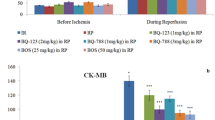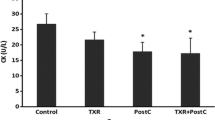Abstract
Ischemic preconditioning (IPC) is one of the most promising strategies used to protect the myocardium from ischemia–reperfusion injury. Ang (1–7) exhibits cardioprotective activity; however, its therapeutic potential on IPC-induced cardioprotection has not been reported in ischemia–reperfusion injury till date. Therefore, the first set of experiment was designed to evaluate the direct effect of Ang (1–7), in perfusion medium, on cardioprotective activity of IPC in rat heart challenged to ischemia–reperfusion injury. In addition, the acute and chronic effects of pretreated Ang (1–7) were investigated on cardioprotection of IPC in ischemia–reperfusion-challenged hearts in subsequent sets of experiments. The results showed that Ang (1–7) potentiated the IPC-induced increase in coronary flow and heart rate, decrease in lactate dehydrogenase and creatine kinase activity, ventricular fibrillation, and infarct size in ischemia–reperfusion-challenged animals in direct and chronic sets of experiments. Further, Ang (1–7) enhanced the IPC-induced attenuation in mitochondrial dysfunction, oxidative stress, and apoptosis in ischemia–reperfusion-challenged hearts in both sets of experiments. A-779, Mas receptor antagonist, abrogated potentiation effects of Ang (1–7) on IPC-induced cardioprotection in ischemia–reperfusion-challenged rats in the above set of experiments. These observations indicate that Ang (1–7)/Mas receptor activation could be a potential adjuvant to IPC during ischemia–reperfusion-induced cardiac injury.






Similar content being viewed by others
References
Mathers CD, Loncar D (2006) Projections of global mortality and burden of disease from 2002 to 2030. PLoS Med 3:e442
Go AS, Mozaffarian D, Roger VL et al (2013) American Heart Association Statistics Committee and Stroke Statistics Subcommittee: Heart disease and stroke statistics—2013 update: a report from the American Heart Association. Circulation 127:e6–e245
Liu M, Zhang P, Chen M, et al (2012) Aging might increase myocardial ischemia/reperfusion–induced apoptosis in humans and rats. Age (Dordr) 34:621–632
Marczak J, Nowicki R, Kulbacka J et al (2012) Is remote ischaemic preconditioning of benefit to patients undergoing cardiac surgery? Interact Cardiovasc Thorac Surg 14:634–639
Han S, Huang W, Liu Y et al (2013) Does leukocyte–depleted blood cardioplegia reduce myocardial reperfusion injury in cardiac surgery? A systematic review and meta–analysis. Perfusion 28:474–483
Murry CE, Jennings RB, Reimer KA (1986) Preconditioning with ischemia: a delay of lethal cell injury in ischemic myocardium. Circulation 74:1124–1136
Yellon DM, Downey JM (2003) Preconditioning the myocardium: from cellular physiology to clinical cardiology. Physiol Rev 83:1113–1151
Sharma A, Singh M (2000) Possible mechanism of cardioprotective effect of angiotensin preconditioning in isolated rat heart. Eur J Pharmacol 406:85–92
Ferreira AJ, Santos RA, Almeida AP (2001) Angiotensin: cardioprotective effect in myocardial ischemia/reperfusion. Hypertension 38:665–668
Mehta PK, Griendling KK (2007) Angiotensin II cell signaling: physiological and pathological effects in the cardiovascular system. Am J Physiol Cell Physiol 292:C82–C97
Nussberger J, Cugno M, Amstutz C et al (1998) Plasma bradykinin in angio-oedema. Lancet 351:1693–1697
Strauss MH, Hall AS (2006) Angiotensin receptor blockers may increase risk of myocardial infarction: unraveling the ARB-MI paradox. Circulation 114:838–854
Ferreira AJ, Santos RA (2005) Cardiovascular actions of angiotensin-(1–7). Braz J Med Biol Res 38:499–507
Lin L, Liu X, Xu J et al (2016) Mas receptor mediates cardioprotection of angiotensin-(1–7) against Angiotensin II-induced cardiomyocyte autophagy and cardiac remodelling through inhibition of oxidative stress. J Cell Mol Med 20:48–57
Westermeier F, Bustamante M, Pavez M et al (2015) Novel players in cardioprotection: Insulin like growth factor-1, angiotensin-(1–7) and angiotensin-(1–9). Pharmacol Res 101:41–55
Bolli R (2000) The late phase of preconditioning. Circ Res 87:972–983
Heusch G, Boengler K, Schulz R (2010) Inhibition of mitochondrial permeability transition pore opening: the Holy Grail of cardioprotection. Basic Res Cardiol 105:151–154
Bernardi P, Di Lisa F (2015) The mitochondrial permeability transition pore: molecular nature and role as a target in cardioprotection. J Mol Cell Cardiol 78C:100–106
Zhao P, Li F, Gao W et al (2015) Angiotensin1-7 protects cardiomyocytes from hypoxia/reoxygenation-induced oxidative stress by preventing ROS-associated mitochondrial dysfunction and activating the Akt signaling pathway. Acta Histochem 117:803–810
National Research Council (US) Committee for the Update of the Guide for the Care and Use of Laboratory Animals (2011) Guide for the care and use of laboratory animals, 8th edn. National Academies Press (US), Washington, DC
Ferreira AJ, Santos RA, Almeida AP (2001) Angiotensin-(1–7): cardioprotective effect in myocardial ischemia/reperfusion. Hypertension 38:665–668
Pawlik MW, Kwiecien S, Ptak-Belowska A et al (2016) The renin-angiotensin system and its vasoactive metabolite angiotensin-(1–7) in the mechanism of the healing of preexisting gastric ulcers. The involvement of Mas receptors, nitric oxide, prostaglandins and proinflammatory cytokines. J Physiol Pharmacol 67:75–91
Goyal A, Semwal BC, Yadav HN (2016) Abrogated cardioprotective effect of ischemic preconditioning in ovariectomized rat heart. Hum Exp Toxicol 35:644–653
Pedersen PL, Greenawalt JW, Reynafarje B et al (1978) Preparation and characterization of mitochondria and submitochondrial particles of rat liver and liver-derived tissues. Methods Cell Biol 20:411–481
Lowry OH, Rosebrough NJ, Farr AL et al (1951) Protein measurement with the Folin phenol reagent. J Biol Chem 193:265–275
Kamboj SS, Kumar V, Kamboj A et al (2008) Mitochondrial oxidative stress and dysfunction in rat brain induced by carbofuran exposure. Cell Mol Neurobiol 28:961–969
Huang SG (2002) Development of a high throughput screening assay for mitochondrial membrane potential in living cells. J Biomol Screen 7:383–389
Ohkawa H, Ohishi N, Yagi K (1979) Assay for lipid peroxides in animal tissues by thiobarbituric acid reaction. Anal Biochem 95:351–358
Green LC, Wagner DA, Glogowski J et al (1982) Analysis of nitrate, nitrite, and [15N] nitrate in biological fluids. Anal Biochem 126:131–138
Kakkar P, Das B, Viswanathan PN (1984) A modified spectrophotometric assay of superoxide dismutase. Indian J Biochem Biophys 21:130–132
Beers JRF, Sizer IW (1952) A spectrophotometric method for measuring the breakdown of hydrogen peroxide by catalase. J Biol Chem 195:133–140
Bradford MM (1976) A rapid and sensitive method for the quantitation of microgram quantities of protein utilizing the principle of protein-dye binding. Anal Biochem 72:248–254
Liu D, **ao B, Han F et al (2912) Single-prolonged stress induces apoptosis in dorsal raphe nucleus in the ratmodel of posttraumatic stress disorder. BMC Psychiatry 12:211
Davie AP, Mcmurray JJ (1999) Effect of angiotensin-(1–7) and bradykinin in patients with heart failure treated with an ACE inhibitor. Hypertension 34:457–460
Javadov SA, Clarke S, Das M et al (2003) Ischaemic preconditioning inhibits opening of mitochondrial permeability transition pores in the reperfused rat heart. J Physiol 549:513–524
Zhao ZQ, Corvera JS, Halkos ME et al (2003) Inhibition of myocardial injury by ischemic postconditioning during reperfusion: comparison with ischemic preconditioning. Am J Physiol Heart Circ Physiol 285:H579–H588
Moon JY, Tanimoto M, Gohda T, et al. (2011) Attenuating effect of angiotensin-(1–7) on angiotensin II-mediated NAD(P)H oxidase activation in type 2 diabetic nephropathy of KK-A(y)/Ta mice. Am J Physiol Renal Physiol 300:F1271–1282
Kim SM, Kim YG, Jeong KH et al (2012) Angiotensin II-induced mitochondrial Nox4 is a major endogenous source of oxidative stress in kidney tubular cells. PLoS One 7:e39739
Xu P, Santos RA, Bader M et al (2007) Alterations in gene expression in the testis of angiotensin-(1–7)-receptor Mas-deficient mice. Regul Pept 138:51–55
Cai SM, Yang RQ, Li Y et al (2016) Angiotensin-(1–7) improves liver fibrosis by regulating the NLRP3 inflammasome via redox balance modulation. Antioxid Redox Signal 24:795–812
Nautiyal M, Katakam PV, Busija DW et al (2012) Differences in oxidative stress status and expression of MKP-1 in dorsal medulla of transgenic rats with altered brain renin-angiotensin system. Am J Physiol Regul Integr Comp Physiol 303:R799–R806
Acknowledgements
PP is thankful to GLA University, Mathura, Uttar Pradesh, India for the financial assistantship.
Author information
Authors and Affiliations
Corresponding author
Ethics declarations
Conflict of interest
Authors report no conflict of interests.
Rights and permissions
About this article
Cite this article
Pachauri, P., Garabadu, D., Goyal, A. et al. Angiotensin (1–7) facilitates cardioprotection of ischemic preconditioning on ischemia–reperfusion-challenged rat heart. Mol Cell Biochem 430, 99–113 (2017). https://doi.org/10.1007/s11010-017-2958-4
Received:
Accepted:
Published:
Issue Date:
DOI: https://doi.org/10.1007/s11010-017-2958-4




